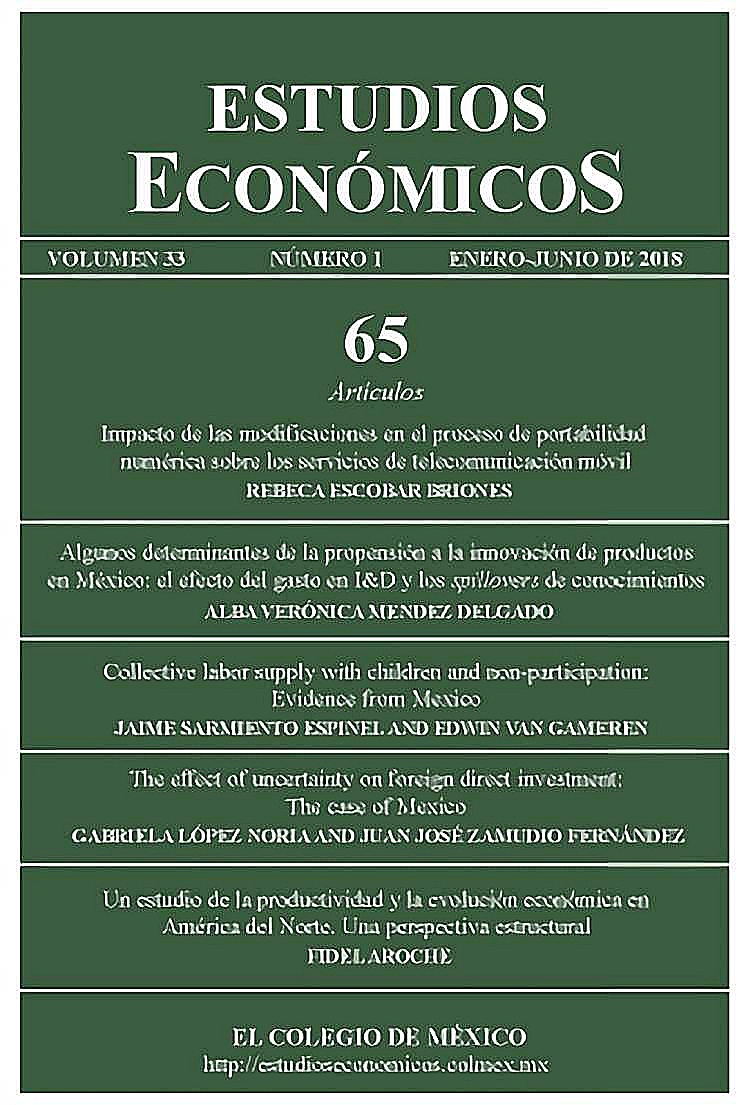Publicado 2018-01-01
Palabras clave
- México,
- costos de traspaso,
- competencia,
- portabilidad numérica,
- mercado de telecomunicaciones móviles
Cómo citar
Resumen
Los costos de traspaso y los efectos de red pueden disuadir la competencia en los mercados de telecomunicaciones al crear un efecto encierro que reduce la movilidad de los consumidores entre los diferentes operadores. El tema ha sido investigado en el contexto internacional, pero hasta el día de hoy las conclusiones no han sido unánimes; además, en países como México, la investigación es escasa. El análisis aporta una estimación de los costos de traspaso para México en el periodo 2007-2016. Asimismo, se evalúa el impacto de los costos de traspaso decrecientes sobre la movilidad de los consumidores y la concentración de mercado, y se encuentra que tienen un efecto favorable.
Descargas
Citas
- Baranes, E. y H.V. Cuong. 2011. Ex-ante asymmetric regulation and retail market competition: Evidence from Europe’s Mobile Industry, Technology and Investment, 2(4): 301-310.
- Biglaiser, G., J. Cremer y G. Dobos. 2014. Heterogenous switching costs, CESifo Working Paper Series, núm. 4587, <https://papers.ssrn.com/sol3/papers.cfm?abstract id=2390630.>
- Buehler, S., R. Dewenter y J. Haucap. 2006. Mobile number portability in Europe, Telecommunications Policy, 30(7): 385-399.
- Cabral. L. 2008. Small switching costs lead to lower prices, WP, New York University y CEPR, <http://pages.stern.nyu.edu/ lcabral/workingpapers/scostsAug08.pdf.>
- Corrocher N. y L. Zirulia. 2009. Me and you and everyone we know: An empirical analysis of local network effects in mobile communications, Telecommunica-tions Policy, 33(1-2): 68-79.
- Cullen, J. y O. Scherbakov. 2010. Measuring consumer switching costs in the wireless industry, <http://webrum.uni-mannheim.de/vwl/ashcherb/fileslib/scwireless final.pdf >(mimeo).
- Czajkowski, M. y M. Sobolewski. 2015. How much do switching costs and local network effects contribute to consumer lock-in in mobile telephony?Telecommunications Policy, 40(9): 855-869.
- Dubé, J.P, G. Hitsch y P. Rossi. 2009. Do switching cost make markets less competitive, Journal of Marketing Research, XLVI: 435-445.
- Escobar Briones, Rebeca. 2016. Estudio de evaluación prospectiva de la regulación asimétrica. Aplicación de tarifas de terminación asimétricas en el servicio móvil en México, Análisis Económico, XXXI(78): 33-60.
- Farrell, J. y P. Klemperer. 2007. Coordination and lock in: Competition with switching costs and network effects, en M. Armstrong y R.H. Porter (comps.), Handbook of Industrial Organization, vol. 3, Amsterdam, Elsevier, pp. 1967-2072.
- Fuentelsaz, L., J.P. Maicas y Y. Polo. 2012. Switching costs, network effects, and competition in the European mobile telecommunications industry, Information Systems Research, 23(1): 93-108.
- Grzybowski, L. 2008. Estimating switching costs in mobile telephony in the UK, Journal of Industry, Competition and Trade, 8(2): 113-132.
- Instituto Federal de Telecomunicaciones (IFT). 2016. Primera encuesta 2016: usuarios de servicios de telecomunicaciones, México, http://www.ift.org.mx/usuarios-y-audiencias/primera-encuesta-2016-usuarios-de-servicios-detelecomunicaciones
- Instituto Federal de Telecomunicaciones (IFT). 2017 Estadísticas de portabilidad, México, << http://www.ift.org.mx/estadisticas/estadisticas-de-portabilidad>>.
- Kim, M.K., M.Ch. Park y D.H. Jeong. 2004. The effects of customer satisfaction and switching barriers on customer loyalty in Korean mobile telecommunication services, Telecommunications Policy, 28(2): 145-159.
- Klemperer, P. 1987. The competitiveness of markets with switching costs, The Rand Journal of Economics, 18(1): 138-150.
- Klemperer, P. 1995. Competition when consumers have switching costs: An overview with applications to industrial organization, macroeconomics, and international trade, Review of Economic Studies, 62: 515-539.
- Knittel, C. 1997. Interstate long distance rates: search costs, switching costs and market power, Review of Industrial Organization, 12: 519-536.
- Lee, J., Y. Kim y J.D. Lee. 2006. Estimating the extent of potential competition in the Korean mobile telecommunications market: Switching costs and number portability, International Journal of Industrial Organization, 24(1): 107-124.
- Lyons, S. 2006. Measuring the benefits of mobile number portability, Trinity Economic Papers, núm. tep2209.
- Maicas, J.P., Y. Polo y F.J. Sese. 2009. Reducing the level of switching costs in mobile communications: The case of mobile number portability, Telecommunications Policy, 33(9): 544-554.
- Martin, Stephen. 2002. Advanced Industrial Economics, Blackwell Publishing, 2a. edicion.
- Nakamura, A. 2010. Estimating switching costs involved in changing mobile phone carriers in Japan: Evaluation of lock-in factors related to Japan’s SIM card locks, Telecommunications Policy, 34(11): 736-746.
- Park, Y. y Y. Koo. 2016. An empirical analysis of switching cost in the smartphone market in South Korea, Telecommunications Policy, 40(4): 307-318.
- Ovum Knowledge Center. 2017. Informa 2017, <https://www.ovumkc.com/login.>;
- Shy, O. 2002. A quick and easy method for estimating switching costs, Interna-tional Journal of Industrial Organization, 20(1): 71-87.
- Suleymanova I. y Ch. Wey. 2008. Bertrand competition in markets with network effects and switching costs, Düsseldorf Institute for Competititon Economics, DP núm. 30, <https://www.econstor.eu/bitstream/10419/48679/1/665466420.pdf.>;
- Tapia Lezama, G. 2013. Costos de traspaso en telefonía móvil. Evidencia para el caso de México, Economía Mexicana, XXII(1): 207-233.
- Usero Sánchez, B. y G. Asimakopoulos. 2012. Regulation and competition in the European mobile communications industry: An examination of the implementation of mobile number portability, Telecommunications Policy, 36(3): 187-196.
- U.S. Department of Justice/Federal Trade Commission. 2010. Horizontal Merger Guidelines,

